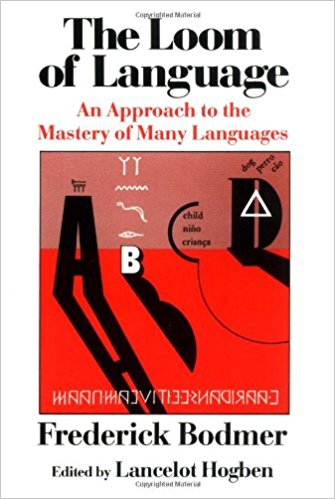The Loom of Language, by Frederick Bodmer (A Review)
The first half of the 20th century was a heady time for language learning and study. The field of philology (now commonly called historical linguistics) was at its zenith. Much of the evolution of the Proto-Indo European language family had been worked out. The hope that a world-wide auxiliary language, such as Esperanto, would be adopted internationally had not yet been utterly dashed by the two World Wars.
In this milieu, Frederick Bodmer published The Loom of Language, an erudite guide on how to study multiple languages efficiently. Bodmer was a professor of philology at MIT during this time. He was succeeded there in 1955 by Noam Chomsky, whose revolutionary ideas were responsible as much as anything for changing philology into what we think of as modern linguistics.
The book was edited by Bodmer's friend Lancelot Hogben, a zoologist turned popular science writer and inventor of the auxiliary language Interglossa, and was part of a series of books entitled Primers for the Age of Plenty that also included volumes on mathematics, general science, and history. The science and history books are long out of print, but the mathematics book, Mathematics for the Million, remains available. (I, of course, own a copy and will review it eventually...)
There is so much great information in here that it requires repeat readings over several years, especially Part II. Consider this book a meta-manual for learning how to learn languages.
It is divided into four parts. Part I is a "natural history" of language. Part II covers the "hybrid heritage" of English as a language which straddles the Germanic and Romance branches of the Indo-European language tree. Part III covers language problems and planning movements. Part IV is a "language museum" of comparative vocabulary tables.
The most fascinating feature of this book is how it frames being a native English speaker as a positive, not a negative. While speaking English might be a disincentive to learn other languages, it can also be a great base to learn from due to its hybrid Germanic/Romantic vocabulary. As such, the book covers Swedish, Danish, Dutch, and German in the Teutonic track and French, Spanish, Portuguese, and Italian in the Romance track, not to mention plenty of discussion of parent languages like Latin and Old English.
The Loom of Language shares much information and spirit with The Seven Sieves. The latter is also very good, but Loom is more comprehensive and easier to find. There is even a scanned copy available on Archive.org.
As I said above, Part II is a treasure trove. Bodmer distills everything a student needs to know about sound correspondences, etc. to make connections across the outlined languages and accelerate learning. The only annoyance is that the huge tables in Part IV aren't available online somewhere as spreadsheets (the book is almost a century old after all) so one could import them into a spaced repetition system like Anki for efficient learning. I typed these out as Google spreadsheets for my own use. I've made them available here: Romance Word List, Germanic Word List, and the Greek Roots List from the language museum. Importing into Anki or suchlike is pretty easy.
With the growth of the "polyglot" trend online, resources that purport to teach you how to learn languages quickly are increasingly common. Fluent in 3 Months by Benny Lewis and Fluent Forever by Gabriel Wyner are two notable examples. However, few of these modern books come close to the rigor of Bodmer's tome.
